Software
This is software that our group developed and that we provide free of charge for academic purposes or under a free software license. We offer ![]() free datasets, too.
free datasets, too.
AQuAFo

AQuAFo (GUI for Automated Quality Assessment of Retinal Fundus Photos) is a Graphical User Interface for Windows to estimate the quality of retinal fundus photos automatically.
More information is available ![]() here.
here.
Android PlotView
The Android PlotView library can be used to plot signals on Android devices. It is implemented as an Android control and has no external dependencies.
More information is available ![]() here.
here.
Camera Calibration with Active Targets
This code accompanies the paper Camera Calibration: Active versus Passive Targets by Christoph Schmalz, Frank Forster and Elli Angelopoulou, (Optical Engineering, November 2011)
Active targets can be digital displays or e-paper. They have several advantages. Digital displays are nearly ubiquitous, so dedicated calibration targets with a fixed checkerboard or dot array pattern become unnecessary. Handling is easy as most displays have a tilt/swivel base to set up different target poses. Also, the target does not have to be in focus to obtain excellent calibration results, which is especially useful for calibrating cameras with a large field of view, since the target can be moved closer to the lens. Most importantly, active targets enable a higher localization accuracy for the calibration marks than traditional passive targets. This translates into a higher accuracy in applications like for example 3D reconstruction tasks.
See the paper and the included readme for further details.
Download link: ![]() ActiveCalib_v1.zip (C++, VC10 project included)
ActiveCalib_v1.zip (C++, VC10 project included)
CAVAREV: CArdiac VAsculature Reconstruction EValuation
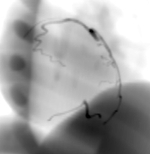
The main goal of ![]() CAVAREV is to enable an easy and objective comparison of different dynamic reconstruction algorithms.
CAVAREV is to enable an easy and objective comparison of different dynamic reconstruction algorithms.
The area of application is the 3-D and 4-D reconstruction of contrasted cardiac vessels, e.g. the coronary arteries using C-arm CT (rotational angiography). Various methods exist in literature with lots of nice results. However, the results can vary significantly between phantom and real clinical data.
Therefore, we provide:
- Open (i.e. public) and easy accessible projection data.
- Anatomically and physiologically correct projection data based on patient data.
- Two degrees of difficulty: (a) Strictly periodic cardiac motion and (b) an aperiodic combination of cardiac and breathing motion.
- An online evaluation platform where 3-D reconstructions can be uploaded and the reconstruction quality is assessed objectively.
For more information please visit ![]() www.cavarev.com.
www.cavarev.com.
CUDA Quasi-Newton Optimization
This is a C++ library for general-purpose, unconstrained non-linear optimization on the GPU using NVIDA's CUDA. It implements the L-BFGS (“Limited-memory Broyden-Fletcher-Goldfarb-Shanno“) method, a popular Quasi-Newton optimization method with a low memory footprint.
More infrmation is available ![]() here
here
CUDA Super-Resolution
This is a C++ implementation of the framework proposed in our paper "GPU Accelerated Time-of-Flight Super-Resolution for Image-Guided Surgery". It employs maximum a posteriori (MAP) estimation to obtain an improved image of higher resolution from multiple low-resolution images. Our implementation accelerates super-resolution on the graphics processing unit (GPU) using NVIDIA's CUDA platform.
More information is available | 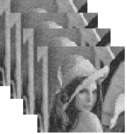  |
Edge Sharpness Comparison
This MATLAB® tool supports comparison of edge sharpness in images, both interactively and in batch mode. ![]() More...
More...
Epipolar Consistency has been shown to be a powerful tool in calibration and motion correction for flat panel detector CT (FD-CT) and other X-ray based applications. The epipolar consistency conditions (ECC) apply to projection data directly and can be used to correct for 3D parameters without 3D reconstruction. The computation of an epipolar consistency metric is real-time capable for small sets of images and can be parallelized for large sets of images. This is an open-source implementation in Octave/MATLAB, which can easily be ported to your favorite software environment.
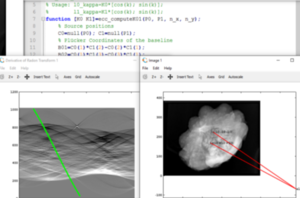
Embedded Classification Software Toolbox (ECST)
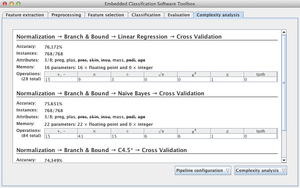
Embedded microcontrollers are employed in an increasing number of applications as a target for the implementation of classification systems. This is true, for example, for the fields of sports, automotive, and medical engineering. However, important challenges arise when implementing classification systems on embedded microcontrollers, which is mainly due to limited hardware resources.
With the ![]() Embedded Classification Software Toolbox, we present a solution to the two main challenges, namely obtaining a classification system with low computational complexity and, at the same time, high classification accuracy. For the first challenge, we propose complexity measures on the mathematical operation and parameter level, because the abstraction level of the commonly used Landau notation is too high in the context of embedded system implementation. For the second challenge, we present a software toolbox that trains different classification systems, compares their classification accuracy, and finally analyzes the complexity of the trained system.
Embedded Classification Software Toolbox, we present a solution to the two main challenges, namely obtaining a classification system with low computational complexity and, at the same time, high classification accuracy. For the first challenge, we propose complexity measures on the mathematical operation and parameter level, because the abstraction level of the commonly used Landau notation is too high in the context of embedded system implementation. For the second challenge, we present a software toolbox that trains different classification systems, compares their classification accuracy, and finally analyzes the complexity of the trained system.
DynaSL - A Digital Perfusion Phantom for T1-weighted DCE-MRI
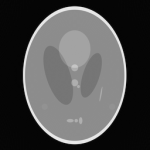
DynaSL is a collection of tools to analyze sampling strategies and reconstruction algorithms for T1-weighted DCE-MRI. It can be used to:
- compute realistic arterial input and tissue attenuation curves using the popular Tofts model
- perform sampling of a dynamic, analytical phantom along arbitrary trajectories
Further information and downloads can be found ![]() here.
here.
FindTBB.cmake
![]() FindTBB.cmake is a
FindTBB.cmake is a ![]() CMake module to automatically find the installation path of Intel's
CMake module to automatically find the installation path of Intel's ![]() Threading Building Blocks.
Threading Building Blocks.
Find more info about ![]() FindTBB.cmake at Google Code.
FindTBB.cmake at Google Code.
Gerbil: Multispectral Image Analysis Framework
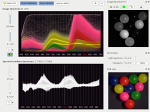
Gerbil is an open-source project intended for researchers working with multispectral or hyperspectral images, or researching and educating in color and reflectance. The software consists of a new interactive visualization tool targeted at multispectral and hyperspectral image data, and a toolbox of common algorithms, e.g. for segmentation.
For more information and download visit ![]() gerbilvis.org.
gerbilvis.org.
Hearty
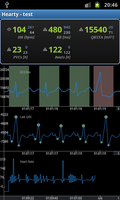
Hearty is an application for Android-based mobile devices that allows real-time electrocardiogram (ECG) monitoring and automated arrhythmia detection by analyzing ECG parameters.
More information is available ![]() here.
here.
Image Denoising Algorithms Archive

The ![]() Image Denoising Algorithms Archive contains a collection of commonly used and state-of-the-art denoising algorithms, implemented in Matlab. The algorithms were used and testet at the Pattern Recognition Lab.
Image Denoising Algorithms Archive contains a collection of commonly used and state-of-the-art denoising algorithms, implemented in Matlab. The algorithms were used and testet at the Pattern Recognition Lab.
Furthermore, data sets for the evaluation of denoising algorithms, which we used in our papers, may be downloaded.
Instantaneous P- and T-Wave detection algorithms
Arrhythmia detection algorithms require the exact and instantaneous detection of fiducial points in the ECG signal. These fiducial points (QRS-complex, P- and T-waves) correspond to distinct cardiac contraction phases.
We implemented in Matlab three algorithms: one is based on a line fitting approach, an expeditious version of a Wavelet-based ECG delineation algorithm, and a fast naive fiducial points detection algorithm.
Download link: ![]() FiducialPointsDetectionAlgorithms.zip
FiducialPointsDetectionAlgorithms.zip
Copy-Move Framework

Code snippets and code from our image forensics research. We put our generalization of the shift vector verification for copy-move forgery detection online, see the ![]() project page for details, proceed to the
project page for details, proceed to the ![]() download of the code. Consider also to
download of the code. Consider also to ![]() download the dataset.
download the dataset.
Java Speech Toolkit (JSTK)
The Java Speech Toolkit (JSTK) is an open source framework for speech processing, licensed under the GPL v3.0 and hosted at Google Code: ![]() http://code.google.com/p/jstk. It provides programs and API functionality for basic signal processing (IO, filtering), feature extraction (MFCC and others), Gaussian mixture model training (ML and MMIE), adaptation, small vocabulary size speech recognition and human rater evaluation.
http://code.google.com/p/jstk. It provides programs and API functionality for basic signal processing (IO, filtering), feature extraction (MFCC and others), Gaussian mixture model training (ML and MMIE), adaptation, small vocabulary size speech recognition and human rater evaluation.
Furthermore, JSTK provides visual components for the rapid development of speech annotation tools, such as JSTKTranscriber (package de.fau.cs.jstk.app.jstktranscriber) and ![]() Blitzscribe2 (package de.fau.cs.jstk.app.blitzscribe).
Blitzscribe2 (package de.fau.cs.jstk.app.blitzscribe).
JPOP: Java parallel optimization package
Java parallel optimization package (JPOP) is an open-source software library which allows the minimization of non-linear functions. The package provides interfaces to implement functions, gradients, and Hessians of arbitrary functions which can be minimized in a parallel manner. ![]() More info.
More info.
Multi-Frame Super-Resolution Toolbox
In this MATLAB toolbox, we provide the implementations of several state-of-the-art algorithms as well as novel methods developed in our projects on muti-frame super-resolution. The algorithms cover general-purpose reconstruction algorithms that exploit subpixel motion to gain super-resolved data and tailor-made solutions for specific applications (with focus on applications in medical imaging).
More information is available ![]() here
here
OCTSEG
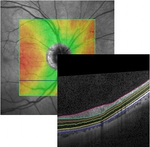
OCTSEG (Optical Coherence Tomography Segmentation and Evaluation GUI) is a
graphical user interface written in MATLAB for research purposes.
The retinal layers and the blood vessels of retinal OCT scans can be segmented. In addition, tools for the manual correction of the automated segmentations and for the visualization of the data are provided.
Further information is available ![]() here.
here.
RabbitCT: Benchmark for High-speed C-arm CT
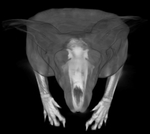
RabbitCT is an open-source benchmark for C-arm CT FBP reconstruction.
It features a software framework for measuring execution time and calculating reconstruction errors, and a clincal C-arm CT dataset with 496 projections.
For more information please visit ![]() rabbitct.com.
rabbitct.com.
Range Imaging Toolkit (RITK)
The ![]() Range Imaging Toolkit (RITK) provides a powerful yet intuitive software platform that facilitates the development of range image stream applications. RITK puts emphasis on real-time processing of range image streams and proposes the use of a dedicated pipeline mechanism. Furthermore, we introduce a powerful and convenient interface for range image processing on the graphics processing unit (GPU). Being designed thoroughly and in a generic manner, the toolkit is able to cope with the broad diversity of data streams provided by available RI devices and can easily be extended by custom range imaging sensors or processing modules. RITK is an open source project. It is an object-oriented, cross-platform toolkit written in C++, that can be used as a regular library as well as an application framework for rapid development.
Range Imaging Toolkit (RITK) provides a powerful yet intuitive software platform that facilitates the development of range image stream applications. RITK puts emphasis on real-time processing of range image streams and proposes the use of a dedicated pipeline mechanism. Furthermore, we introduce a powerful and convenient interface for range image processing on the graphics processing unit (GPU). Being designed thoroughly and in a generic manner, the toolkit is able to cope with the broad diversity of data streams provided by available RI devices and can easily be extended by custom range imaging sensors or processing modules. RITK is an open source project. It is an object-oriented, cross-platform toolkit written in C++, that can be used as a regular library as well as an application framework for rapid development.
UnivIS2Typo3
A Generic Link Between UnivIS and Typo3
More information:![]() UnivIS2Typo3 project page at the LME
UnivIS2Typo3 project page at the LME![]() UnivIS2Typo3 repository at GoogleCode
UnivIS2Typo3 repository at GoogleCode
ORCA-SPOT: An Automatic Killer Whale Sound Detection Toolkit Using Deep Learning
ORCA-SPOT is a deep learning toolkit implemented in PyTorch and designed to segment interesting animal sounds (killer whale signals) out of large, noise-heavy, and heterogenous bioacoustic audio corpora. ORCA-SPOT can be adapted to other animal species. The code will be publicly available upon request only at the end of October 2019. For questions please contact Christian Bergler (christian.bergler@fau.de).



 +49-9131-85-27775
+49-9131-85-27775
 +49-9131-85-27270
+49-9131-85-27270
